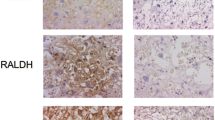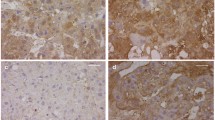Abstract
Background
Retinoids are essential for fetal and lung development. Beta-carotene(BC) is the main dietary retinoid source and beta-carotene-15,15′-oxygenase-1 and 2 (Bcmo1,2) is the primary enzyme generating retinoid from BC in adult mammalian tissues. Placenta has a major role in the retinol homeostasis in fetal life: Since there is no fetal retinol synthesis, maternal retinol has to cross the placenta. It has been recently shown that BC can be converted to retinol by Bcmo1,2 in placenta for retinol transfer and moreover, BC can cross the placenta intact. The placental Bcmo1,2 expression is tightly controlled by placental retinol level. In severe retinol deficiency it has been shown that placental Bcmo1,2 expression are increased for generating retinol from dietary maternal BC even when the main retinol transfer is blocked. In recent years, low pulmonary retinol levels and disrupted retinoid signaling pathway have been implicated in the pathogenesis of pulmonary hypoplasia and congenital diaphragmatic hernia (CDH) in the nitrofen model of CDH. Recently, it has been demonstrated that the main retinol transfer in the placenta is blocked in the nitrofen model of CDH causing increased placental and decreased serum retinol level. The aim of our study was to determine maternal and fetal β-carotene levels and to investigate the hypothesis that placental expression of BCMO1 and BCMO2 is altered in nitrofen-exposed rat fetuses with CDH.
Methods
Pregnant rats were exposed to either olive oil or nitrofen on day 9 of gestation (D9). Maternal and fetal serum, placenta, liver and left lungs were harvested on D21 and divided into two groups: control (n = 8) and nitrofen with CDH (n = 8). Immunochistochemistry was performed to evaluate trophoblasts by cytokeratin expression and placental Bcmo1,2 expression. Expression levels of Bcmo1,2 genes in fetal lungs and liver were determined using RT-PCR and immunohistochemistry. BC level was measured using HPLC.
Results
Markedly increased decidual Bcmo1,2 immunoreactivity was observed in CDH group compared to controls. There was no difference neither in the trophoblastic Bcmo1,2 immunoreactivity nor in the pulmonary and liver Bcmo1,2 expression compared to controls. There was no significant difference in maternal serum BC levels between control and CDH mothers (2.14 ± 0.55 vs 2.56 ± 1.6 μM/g, p = 0.8). BC was not detectable neither in the fetal serum nor liver or lungs.
Conclusions
Our data show that nitrofen increases maternal but not fetal Bcmo1,2 expression in the placenta in nitrofen-induced CDH group. The markedly increased decidual Bcmo1,2 expression suggests that nitrofen may trigger local, decidual retinol synthesis in the nitrofen model of CDH.


Similar content being viewed by others
References
Robinson PD, Fitzgerald DA (2007) Congenital diaphragmatic hernia. Paediatr Respir Rev 8(4):323–334 (quiz 334–325)
Colvin J, Bower C, Dickinson JE, Sokol J (2005) Outcomes of congenital diaphragmatic hernia: a population-based study in Western Australia. Pediatrics 116(3):e356–e363
Montedonico S, Nakazawa N, Puri P (2008) Congenital diaphragmatic hernia and retinoids: searching for an etiology. Pediatr Surg Int 24(7):755–761
Chen F, Marquez H, Kim YK, Qian J, Shao F, Fine A, Cruikshank WW, Quadro L, Cardoso WV (2014) Prenatal retinoid deficiency leads to airway hyperresponsiveness in adult mice. J clinical invest 124(2):801–811
Wassef L, Shete V, Hong A, Spiegler E, Quadro L Beta-Carotene supplementation decreases placental transcription of LDL receptor-related protein 1 in wild-type mice and stimulates placental beta-carotene uptake in marginally vitamin A-deficient mice. J Nutr 142(8):1456–1462
Wassef L, Spiegler E, Quadro L Embryonic phenotype, beta-carotene and retinoid metabolism upon maternal supplementation of beta-carotene in a mouse model of severe vitamin A deficiency. Arch Biochem Biophys 539(2):223–229
Nakazawa N, Montedonico S, Takayasu H, Paradisi F, Puri P (2007) Disturbance of retinol transportation causes nitrofen-induced hypoplastic lung. J Pediatr Surg 42(2):345–349
Beurskens LW, Tibboel D, Lindemans J, Duvekot JJ, Cohen-Overbeek TE, Veenma DC, de Klein A, Greer JJ, Steegers-Theunissen RP (2010) Retinol status of newborn infants is associated with congenital diaphragmatic hernia. Pediatrics 126(4):712–720
Nakazawa N, Takayasu H, Montedonico S, Puri P (2007) Altered regulation of retinoic acid synthesis in nitrofen-induced hypoplastic lung. Pediatr Surg Int 23(5):391–396
Kutasy B, Friedmacher F, Pes L, Paradisi F, Puri P (2014) Increased uptake of dietary retinoids at the maternal-fetal barrier in the nitrofen model of congenital diaphragmatic hernia. J Pediatr Surg 49(6):866–870
Kutasy B, Pes L, Friedmacher F, Paradisi F, Puri P: Nitrofen increases total retinol levels in placenta during lung morphogenesis in the nitrofen model of congenital diaphragmatic hernia. Pediatr Surg Int
Kutasy B, Gosemann JH, Doi T, Fujiwara N, Friedmacher F, Puri P (2012) Nitrofen interferes with trophoblastic expression of retinol-binding protein and transthyretin during lung morphogenesis in the nitrofen-induced congenital diaphragmatic hernia model. Pediatr Surg Int 28(2):143–148
Tadesse S, Luo G, Park JS, Kim BJ, Snegovskikh VV, Zheng T, Hodgson EJ, Arcuri F, Toti P, Parikh CR et al: Intra-amniotic infection upregulates neutrophil gelatinase-associated lipocalin (NGAL) expression at the maternal-fetal interface at term: implications for infection-related preterm birth. Reprod Sci 18(8):713–722
Clagett-Dame M, DeLuca HF (2002) The role of vitamin A in mammalian reproduction and embryonic development. Annu Rev Nutr 22:347–381
Spiegler E, Kim YK, Wassef L, Shete V, Quadro L (2012) Maternal-fetal transfer and metabolism of vitamin A and its precursor beta-carotene in the developing tissues. Biochim Biophys Acta 1821(1):88–98
Kam RK, Deng Y, Chen Y, Zhao H (2012) Retinoic acid synthesis and functions in early embryonic development. Cell Biosci 2(1):11
Wassef L, Shete V, Hong A, Spiegler E, Quadro L (2012) beta-Carotene supplementation decreases placental transcription of LDL receptor-related protein 1 in wild-type mice and stimulates placental beta-carotene uptake in marginally vitamin A-deficient mice. J Nutr 142(8):1456–1462
Kim YK, Wassef L, Chung S, Jiang H, Wyss A, Blaner WS, Quadro L Beta-Carotene and its cleavage enzyme beta-carotene-15,15′-oxygenase (CMOI) affect retinoid metabolism in developing tissues. FASEB J Off Publ Federation Am Soc Exp Biol 25(5):1641–1652
Lindqvist A, He YG, Andersson S (2005) Cell type-specific expression of beta-carotene 9′,10′-monooxygenase in human tissues. J Histochem Cytochem 53(11):1403–1412
Scaife AR, McNeill G, Campbell DM, Martindale S, Devereux G, Seaton A (2006) Maternal intake of antioxidant vitamins in pregnancy in relation to maternal and fetal plasma levels at delivery. Br J Nutr 95(4):771–778
Dixon JL, Kim YK, Brinker A, Quadro L (1841) Loss of beta-carotene 15,15′-oxygenase in developing mouse tissues alters esterification of retinol, cholesterol and diacylglycerols. Biochim Biophys Acta 1:34–43
Author information
Authors and Affiliations
Corresponding author
Rights and permissions
About this article
Cite this article
Takahashi, H., Kutasy, B., Pes, L. et al. Decidual β-carotene-15,15′-oxygenase-1 and 2 (BCMO1,2) expression is increased in nitrofen model of congenital diaphragmatic hernia. Pediatr Surg Int 31, 37–43 (2015). https://doi.org/10.1007/s00383-014-3621-8
Accepted:
Published:
Issue Date:
DOI: https://doi.org/10.1007/s00383-014-3621-8




